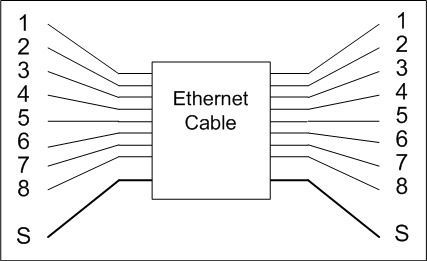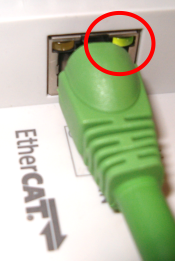Measurements of the cable section
Notes on the recommended acceptance of an Ethernet section for use with EtherCAT
An acceptance measurement of the cable section, consisting of cables including connectors, can be performed in several steps, depending on the available test equipment:
1. Validation using a continuity tester
indicates incorrect assignment, lack of screen contact, poor contacting, dirty contacts
 Fig.32: Continuity test
Fig.32: Continuity test 2. Link control
Ethernet devices feature an optical LINK display (usually directly on the socket), which indicates directly whether a point-to-point connection could be established between the two end points by exchanging the idle symbol
 Fig.33: Link LED on Ethernet devices
Fig.33: Link LED on Ethernet devices 3. Certification
Broadband measurement using a certifier: indicates incorrect assignment, lack of screen contact, poor contacting, dirty contacts, damaged cables/plugs, poor attachment of field-configured plugs.
It must be ensured that the device is correctly adjusted!
 Fig.34: Example illustration of a cable certifier
Fig.34: Example illustration of a cable certifier 4. TwinCAT operating test
Several fault patterns can be discovered at software level using TwinCAT:
- Link LED on couplers, link check of the EtherCAT Slaves or link status in the EtherCAT Device Status:
incomplete contacting, incorrect core assignment
- Lost frames/CRC error: intermittent contacts, screening effect in operation, aging, EMC influences
 Fig.35: TwinCAT diagnosis
Fig.35: TwinCAT diagnosis  | Notes on measurement • The “screen measurement” is usually only a static continuity measurement. It is not possible to test the effectiveness of the cable screen in the field at present (2011); see screening notes. • The measuring devices/cable should not be moved during the high frequency measurement • Poor plug contacts/cable breakages should be sought purposefully using continuity testers |
Test equipment
The testing of Ethernet cabling is possible in the form of validation, qualification or certification. Various test devices for laboratory and field use are available on the market for this.
|
Test |
Scope |
Price range |
|---|---|---|
|
Validation |
low-frequency/static test of continuity, breakage, short-circuit and wiring |
< 100€ |
|
Qualification |
‘narrow-band’ test of whether a certain network technology (e.g. 100Base-TX) can be implemented |
|
|
Certification |
wideband measurement against the standards; reproducibly high measuring accuracy in the measuring device is necessary |
approx. €8000 to any |
In the handicraft installation sector, acceptance test measurements are usually carried out using certifiers that can check an Ethernet cable in 10 to 20 seconds.
 | Accuracy of the field checker Field checkers of the accuracy class IIE or better (III, IIIE, IV) are to be used as per EN61935-1 for the certification of transmission links of performance class D as per EN50173-1. Note that the measurement uncertainty achieved/assured by the measuring device typically lies within the range from 1 to 5 dB, depending on the frequency and measurement (see corresponding information from the device manufacturer). The measurement statement is to be regarded critically as soon as the measured value determined by the measuring device lies within the respective +/- limit value range of the measuring accuracy. The results are not to be evaluated by the measuring device as definitely “good” or “bad”, but as possibly “good” or “bad”. |